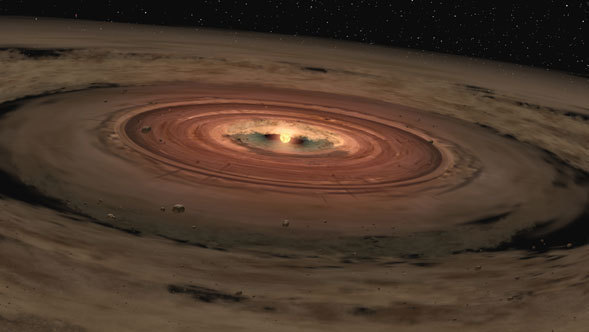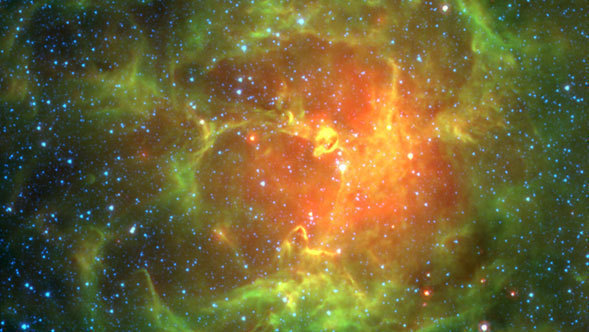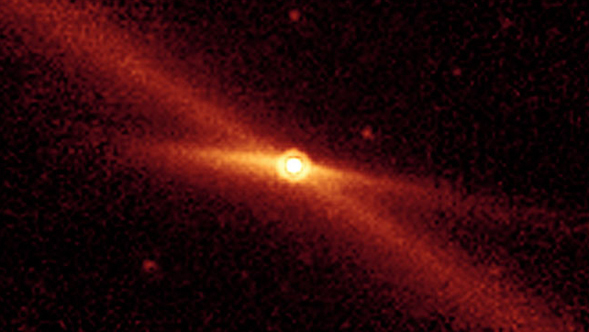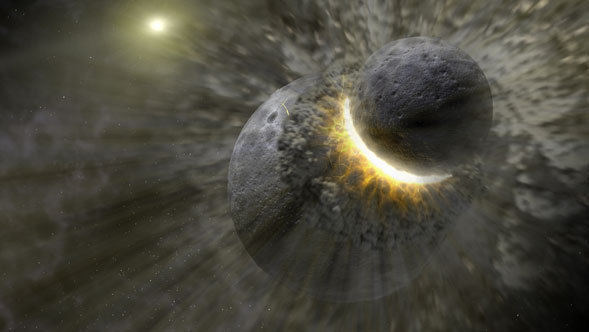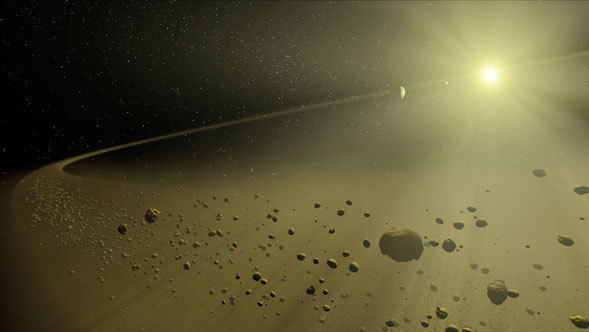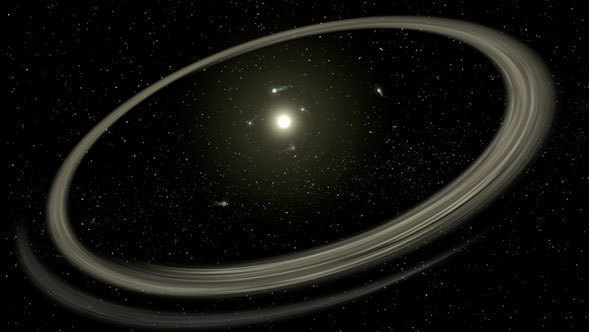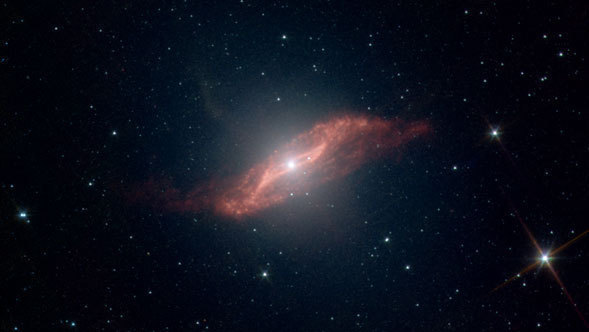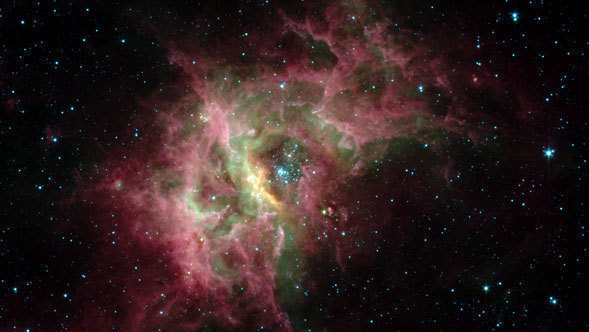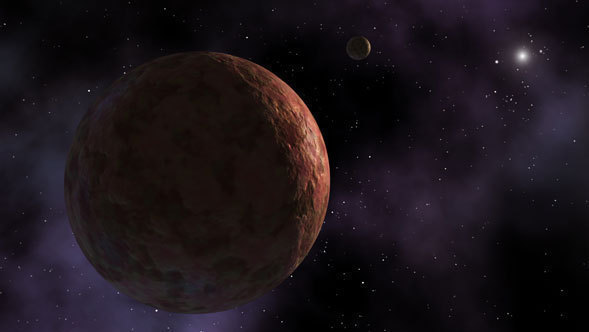Displaying news 481 - 510 of 516 in total
Moons circle planets, and planets circle stars. Now, astronomers have learned that planets may also circle celestial bodies almost as small as planets.
NASA's Spitzer Space Telescope has uncovered a hatchery for massive stars.
Astronomers have numerous technical terms and numbering systems for describing the universe, but one type of mysterious object has yet to be classified. For now, these oddities are named for their strange appearance. They are called blobs.
When our solar system was young, its biggest babies ”Jupiter and Saturn” threw tantrums by the trillion. The huge planets hurled ice-covered rocky bodies from the inner solar system far past the orbit of Pluto.
The National Optical Astronomy Observatory (NOAO) has teamed with the Spitzer Science Center (SSC) to offer a dozen graduates from NOAO's advanced teacher professional development program a unique chance to make research-quality observations with NASA's Spitzer Space Telescope.
Astronomers say a dusty disk swirling around the nearby star Vega is bigger than earlier thought. It was probably caused by collisions of objects, perhaps as big as the planet Pluto, up to 2,000 kilometers (about 1,200 miles) in diameter.
On January 1, 2005, Spitzer was honored in the 116th Rose Parade. The JPL-Caltech float, called "A Family of Explorers," received the Crown City Innovation Trophy for Best Use of Imagination & Innovation to Advance the Art of Float Design.
When you watch the 116th Rose Parade on January 1, 2005, you'll see something spectacular: a gigantic Explorer figure which rises to 50 feet above the parade route and features nine spacecraft, including the Spitzer Space Telescope. This year, NASA's Jet Propulsion Laboratory and the California Institute of Technology will have a monumental float called "A Family of Explorers" in the annual Tournament of Roses Parade.
The Spitzer Science Center (SSC) with the collaboration of the National Optical Astronomy Observatory (NOAO) has designed a program for teacher and student research using observing time on the Spitzer Space Telescope. The participating teachers will attend a fall 2004 workshop to become familiar with the Spitzer Space Telescope archives and to receive training in infrared astronomy and observational techniques. The teachers will also attend a workshop offered by the SSC to learn about the observation planning process and telescope and instrument capabilities.
Two of NASA's Great Observatories, the Spitzer Space Telescope and the Hubble Space Telescope, have provided astronomers an unprecedented look at dusty planetary debris around stars the size of our Sun.
Two new results from NASA's Spitzer Space Telescope released today are helping astronomers better understand how stars form out of thick clouds of gas and dust, and how the molecules in those clouds ultimately become planets.
The astronomical community has received a new gift -- bundles of spruced up data from NASA's Spitzer Space Telescope. The data offer fresh infrared views of the universe, including dozens of images of galaxies and stars, and numerous chemical "fingerprints," or spectra, of planet-forming discs.
A "monster" lurking behind a blanket of cosmic dust is unveiled in this new Halloween image from NASA's Spitzer Space Telescope. Resembling a ghoul with two hollow eyes and a screaming mouth, this masked cloud of newborn stars was uncovered by Spitzer's heat-seeking infrared eyes.
Planets are built over a long period of massive collisions between rocky bodies as big as mountain ranges, astronomers announced today.
Just when astronomers thought they might have dug up the last of our galaxy's "fossils," they've discovered a new one in the galactic equivalent of our own backyard.
Four hundred years ago, sky watchers, including the famous astronomer Johannes Kepler, best known as the discoverer of the laws of planetary motion, were startled by the sudden appearance of a "new star" in the western sky, rivaling the brilliance of the nearby planets.
NASA's Spitzer Space Telescope has set its infrared sight on a major galactic collision and witnessed not death, but a teeming nest of life.
So just how good are Spitzer's infrared eyes? Well, the primary definition of that is what we call resolving power.
A new image from NASA's Spitzer Space Telescope shows the shimmering embers of a dying star, and in their midst a mysterious doughnut-shaped ring.
What would our Milky Way galaxy look like if we could travel outside it and snap a picture? It might look a lot like a new image by NASA's Spitzer Space Telescope of a spiral galaxy called NGC 7331 -- a virtual twin of our Milky Way.
Astronomers unveiled the deepest images from NASA's new Spitzer Space Telescope today and announced the detection of distant objects -- including several supermassive black holes -- that are nearly invisible in even the deepest images from telescopes operating at other wavelengths.
Peering into the "gut" of the galaxy Centaurus A, NASA's Spitzer Space Telescope has captured in unprecedented detail this massive galaxy's last big meal: a spiral galaxy twisted into a parallelogram-shaped structure of dust.
Ten years ago, a group of astronomers set out to find invisible, or dark, matter in the outer fringes of our galaxy. Now, NASA's Spitzer Space Telescope has set its infrared eyes on this mystery matter and verified that at least one of 17 invisible objects observed years ago lies within the body of our Milky Way galaxy.
NASA has announced new findings from the Spitzer Space Telescope, including the discovery of significant amounts of icy organic materials sprinkled throughout several "planetary construction zones," or dusty planet-forming discs, which circle infant stars.
Like a philanthropist donating a prized collection to a museum, NASA's Spitzer Space Telescope has opened a virtual vault rich with scientific data. The Spitzer Science Archive now provides astronomers access to the infrared telescope's data well before the mission's one-year anniversary in space.
Hidden behind a curtain of dusty darkness lurks one of the most violent pockets of star birth in our galaxy. Called DR21, this stellar nursery is so draped in cosmic dust that it appears invisible to the human eye.
NASA-funded researchers have discovered the most distant object orbiting Earth's Sun. The object is a mysterious planet-like body three times farther from Earth than Pluto.
In a small nearby galaxy lies a luminous cloud of gas and dust, called a nebula, which houses a family of newborn stars. If not for the death of a massive star millions of years ago, this stellar nursery never would have formed.
Aviation Week & Space Technology magazine has honored the teams that built NASA's new Spitzer Space Telescope with a 2003 Aerospace Laurel award. The awards, now in their 47th year, recognize outstanding achievements in the global field of aerospace.
Out of the dark and dusty cosmos comes an unusual valentine -- a stellar nursery resembling a shimmering pink rosebud. This cluster of newborn stars, called a reflection nebula, was captured by state-of-the-art infrared detectors onboard NASA's new Spitzer Space Telescope, formerly known as the Space Infrared Telescope Facility.
Displaying news 481 - 510 of 516 in total
